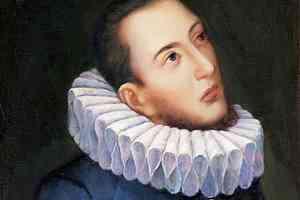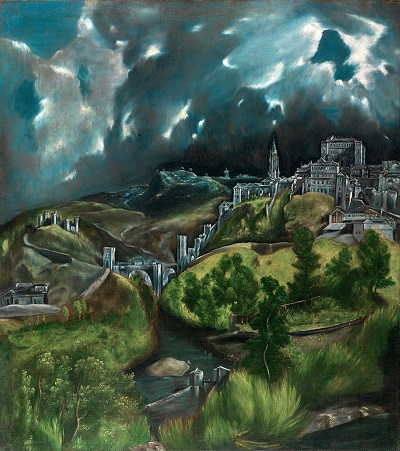


Carlo Gesualdo
Source:
Singers
Born circa 30 March 1566, Carlo Gesualdo (also Gesualdo da Venosa) enjoyed that status which occurs when one's family owns a principality, namely, Verona in southern Italy, since 1560. The Prince of Venosa and Count of Conza, upon his elder brother's death in 1584, was also among the more beloved personalities of the late Renaissance, skilled in composition, lute and murder. Gesualdo was and remains well-known for his extensive corpus of secular works contained in six books of madrigals. Without neglecting that entirely, herein we more focus on his sacred works. Gesualdo published his first motet, 'Delicta nostra ne reminiscaris, Domine' ('Remember Not Our Sins, Lord'), in 1585 at age nineteen. if the Prince of Verona was also a prince of a musician as a minor composer, he is often referred to as a prince of darkness as well. Upon discovering his wife of two years in bed with another man in 1588 Gesualdo killed both of them, wife by sword, her lover by gun. Though as a noble Gesualdo was immune from correction, he left Verona for fear of revenge from the families of his victims.
In 1594 Gesualdo arrived in Ferrara to publish his first book, 'Madrigali del Venosa Libro Priomo'. A letter indicates that he also composed for the Concerto delle Donne in Ferrara. Founded by Alfonso II, Duke of Ferrara, the Concerto delle Donne was a trio of female vocalists popular from 1580 to 1597. Playing instruments as well, among their venues was the court (private) ballet. Ballet had originated as a rigidly technical dance in Italy in the 15th century. Later in the twentieth Igor Stravinsky orchestrated numerous of Gesualdo's madrigals for 'Monumentum pro Gesualdo', a 1948 ballet production by George Balanchine performed by the New York City Ballet. Numerous interpretations of 'Monumentum pro Gesualdo' would arrive over the years.
The court of Alfonso II was also host to the Mannerism of the late Renaissance prior to the arrival of the baroque. Mannerism was the stylization of Renaissance art that had arrived around 1530. If the masters of the Renaissance studied anatomy to draw the human body correctly, a mannerist might elongate the limbs. If the masters studied pigments to paint human flesh in accurate tones, a mannerist might use colors in exaggeration to express a theme. If the masters studied how to lay out paintings toward an engaging but balanced focus, a mannerist might embroider on subjects therein. That is, painters more interested in ideas than depicting scenes no longer adhered to the academics of the scientific masters of the Renaissance (Leonardo da Vinci, Michelangelo, et al). The creative emphasis on idea over the perfect anatomy of David in marble wrought an artificiality characteristic of Mannerist art. Gesualdo had been born into a Manneristic world and his arrival to the court of Alfonso II was late in its period, as the elaborations of Mannerism were at the fountain of the baroque period just beginning at the time. Below is high mannerism painted by El Greco in Spain sometime 1596-1600, one of two landscapes by him, both of Toledo.

View of Toledo El Greco
High Mannerism 1596-1600
Source: Wikipedia
Gesualdo returned to the castled town of what is now called Gesualdo (in Avellino) in his honor in 1595. He married into the powerful Este family in 1597, apparently another unhappy relationship. Gesualdo is said to have suffered from depression in his latter years, there indications that feelings of guilt for his earlier murders were rearing their head. Along with keeping a servant whose duty it was to beat him "at stool" Gesualdo engaged in unsuccessful search for relics. Nevertheless, his collection of spiritual madrigals in 'Tenebrae Responsoria' published in 1611 is considered by not a few to be his most powerful work.
The music of Gesualdo below descends largely by publishing date because composition dates are a dig beyond the bit on this drill. They may or may not have been written fairly close to when they saw print. We begin in the latter half of Gesualdo's career with his motet, 'Ave, dulcissima Maria' ('Hail, sweetest Mary') published in 'Sacrarum Cantionum Liber Primus' by Giovanni Pietro Cappuccio in Naples in 1603.
'Ave, dulcissima Maria' Motet a 5 Carlo Gesualdo
No.3 of 'Sacrarum Cantionum Liber Primus' 1603
Ensemble Vocal Européen / Philippe Herreweghe
Gesualdo published his fifth and sixth books of madrigals in 1611. 'Asciugate i begli occhi' is from his fifth. Included below is Stravinsky's orchestration for the 1948 ballet, 'Monumentum pro Gesualdo' more recently performed by the Bavarian Radio Symphony Orchestra.
'Asciugate i begli occhi' Madrigal a 5 Carlo Gesualdo
No.14 of 'Madrigali a cinque voci Libro Quinto' 1611
La Venexiana
'Asciugate i begli occhi' Orchestration for ballet by Igor Stravinsky 1948
Bavarian Radio Symphony Orchestra conducted by Paul Sacher 2014
'Madrigali a cinque voci Libro Sesto' Madrigals a 5 Carlo Gesualdo Pub 1611
Ensemble Métamorphoses / Maurice Bourbon 1996
Also appearing in 1611 was Gesualdo's 'Responsoria et alia ad officium Hebdomadae Sanctae spectantia' more simply known as 'Responsoria'. This consists of three parts each consisting of three nocturnos also in three: 'Tenebrae Responsories for Maundy Thursday', 'Tenebrae Responsories for Holy Friday' and 'Tenebrae Responsories for Holy Saturday'. A canticle and Psalm are appended to a total of 29 pieces.
'Tenebrae Responsories for Maundy Thursday' Responsories a 6 Carlo Gesualdo
Part 1 of 'Responsoria' 1611
The King's Singers
'Omnes amici mei' Responsory a 6 Carlo Gesualdo
No.1 of Part 2 of 'Responsoria' ('Tenebrae Responsories for Holy Friday') 1611
La Compagnia del Madrigale
'Miserere' Setting to 'Psalm 51' (King James) a 6 Carlo Gesualdo
No.29 of 'Responsoria' 1611
Vocalconsort Berlin / James Wood
Gesualdo wrote a total of five instrumentals. His secular 'Gagliarda del Principe di Venosa' for keyboard might have arrived at any time during his career. It was transcribed into manuscript posthumously sometime between 1614 and 1620. It is shelved at the Conservatory di San Pietro a Majella in Naples as No.4.6.3. Unlike sacred music in which performers more adhered to compositions due being glued to edicts of the Church, Gesualdo would have expected his skeletal secular instrumentals to be variously arranged. Pieces for keyboard at the time were often intended as only a basis for which it was anticipated that others like performers would bring to fuller expression, something they didn't do with the Church. This split personality between conservative and liberal was long exercize in classical music. Humanism was part of the dialogue as well during the first half of Gesualdo's career in the latter 16th century when the late Renaissance became a counterpoint battleground to emerge in baroque. Gesualdo himself meanwhile remained content with madrigals. See below a discussion comparing the madrigals of Gesualdo to Monteverdi in which Landon Cina connects Gesualdo to baroque via Mannerism interpreted in his music in a culmination of the late Renaissance, but reserves the initial baroque madrigals to Monteverdi in his fourth and fifth books of madrigals in 1603 and 1605.
'Gagliarda del Principe di Venosa' Dance (galliard) for keyboard Carlo Gesualdo
Not known when composed Copied into MS posthumously sometime 1614-20
The King's Noyse / David Douglass Album 'Italian Renaissance Dances Vol 1' 2001
By way of summary, between sacred and secular the Oxford Camerata decides it with their 1993 album, 'Gesualdo: Complete Sacred Music for Five Voices', this a collection beginning with motets published in 1603.
'Gesualdo: Complete Sacred Music for Five Voices'
Oxford Camerata / Jeremy Summerly Naxos 1993
From pubs 1603 onward
Gesualdo died at his castle in Avellino on 8 September 1613.
Sources & References for Carlo Gesualdo:
Landon K. Cina (Gesualdo's Late Madrigal Style: Renaissance or Baroque? / Cedarville University 2020)
Gesualdo Online (chronology)
Uncle Dave Lewis (All Music)
VF History (notes)
Wikipedia (English)
Wikipedia (Italian)
Audio of Gesualdo: Classical Archives
Compositions: Corpus: CPDL Wikipedia
Compositions: Individual (relevant herein):
Gagliarda del Principe di Venosa (comp unknown / MS posthumous c 1614-1620)
Tenebrae Responsories for Maundy Thursday (Part 1 of Responsoria pub 1611)
The Concerto delle Donne (female trio 1580-1597):
Mannerism:
The Art Story Britannica Course Hero
Kelly Richman-Abdou Visual-Arts-Cork Wikipedia
Murder of Wife and Her Lover:
Publications: Corpus: CPDL Madrigals Wikipedia
Publications: Individual (relevant herein):
Madrigali del Venosa Libro Primo (first of 6 books of madrigals 1594):
CPDL Facsimile Facsimile Oggi Wikipedia Wikipedia
Madrigali a cinque voci Libro Quinto (1611): CPDL IMSLP Wikipedia
Madrigali a cinque voci Libro Sesto (1611): CPDL IMSLP Wikipedia
Responsoria (Responsoria et alia ad Officium Hebdomadae Sanctae spectantia 1611) containing:
A: Tenebrae Responsories for Maundy Thursday (3 nocturnos)
B: Tenebrae Responsories for Holy Friday (3 nocturnos)
C: Tenebrae Responsories for Holy Saturday (3 nocturnos)
Corpus: CPDL IMSLP RISM Wikipedia
Sacrarum Cantionum Liber Primus (pub by Cappuccio in Naples 1603):
Recordings of Gesualdo: Catalogs:
45 Worlds ClassicalNet DAHR Discogs
Recordings of Gesualdo: Select (relevant herein):
Gesualdo: Complete Sacred Music for Five Voices by the Oxford Camerata / Jeremy Summerly / Naxos 1993:
Madrigals Book 2 by Delitiæ Musicæ / Marco Longhini / Naxos
Responsoria 1611 by La Compagnia del Madrigale / 2014
Tenebrae Responsories for Holy Saturday by the Tallis Scholars / Peter Phillips / 1987
Scores / Sheet Music: Corpus: CPDL IMSLP Musicalics
Scores / Sheet Music: Individual (relevant herein):
Asciugate i begli occhi (madrigal pub 1611)
Ave, dulcissima Maria (motet pub 1603)
Sacrarum Cantionum Liber Primus (pub by Cappuccio in Naples 1603):
Tenebrae Responsories for Holy Saturday (Part 3 of Responsoria pub 1611)
Further Reading:
Catholic relics: New Advent Rick Paulas ScriptureCatholic
Carlo Gesualdo:
Chris Blackford (Prince of Pain)
Oregon Ballet Theatre (Behind the Music of Carlo Gesualdo Part 1)
Oregon Ballet Theatre (Behind the Music of Carlo Gesualdo Part 2)
Wikipedia (Madrigals by Carlo Gesualdo)
Authority Search: VIAF World Cat
Other Profiles: Britannica Britannica Encyclopedia Study
Classical Main Menu Modern Recording
hmrproject (at) aol (dot) com